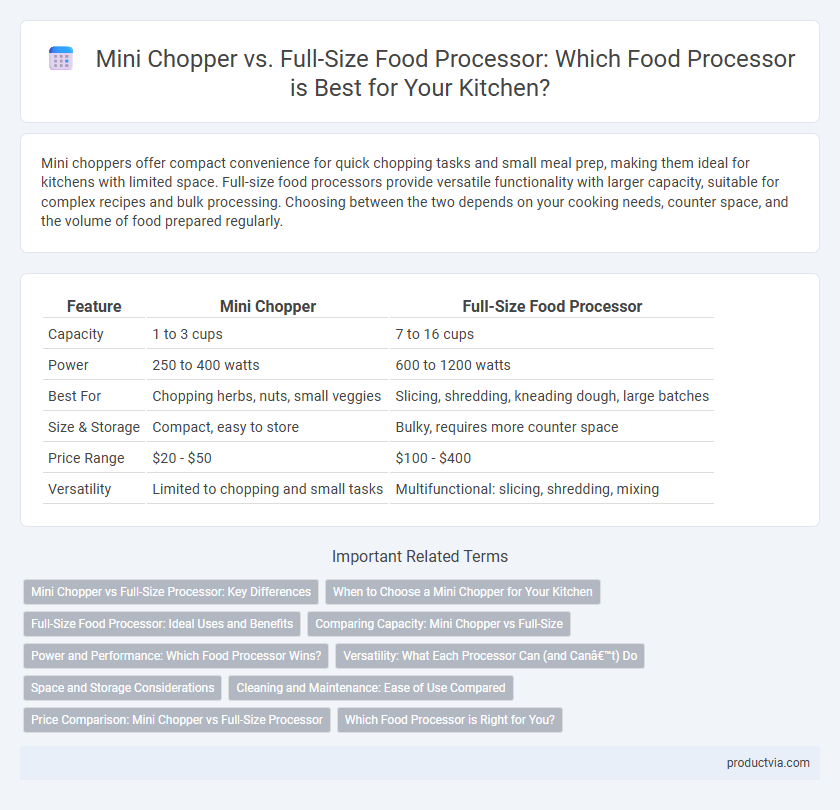Mini choppers offer compact convenience for quick chopping tasks and small meal prep, making them ideal for kitchens with limited space. Full-size food processors provide versatile functionality with larger capacity, suitable for complex recipes and bulk processing. Choosing between the two depends on your cooking needs, counter space, and the volume of food prepared regularly.
Table of Comparison
| Feature | Mini Chopper | Full-Size Food Processor |
|---|---|---|
| Capacity | 1 to 3 cups | 7 to 16 cups |
| Power | 250 to 400 watts | 600 to 1200 watts |
| Best For | Chopping herbs, nuts, small veggies | Slicing, shredding, kneading dough, large batches |
| Size & Storage | Compact, easy to store | Bulky, requires more counter space |
| Price Range | $20 - $50 | $100 - $400 |
| Versatility | Limited to chopping and small tasks | Multifunctional: slicing, shredding, mixing |
Mini Chopper vs Full-Size Processor: Key Differences
Mini choppers offer compact design and convenience for small tasks like chopping herbs, nuts, or garlic, making them ideal for quick, everyday food prep. Full-size processors feature larger capacity bowls and more powerful motors, enabling them to handle complex tasks such as kneading dough, shredding large quantities, and slicing vegetables efficiently. While mini choppers excel in portability and space-saving, full-size processors provide versatile culinary functions suitable for extensive meal preparation.
When to Choose a Mini Chopper for Your Kitchen
A mini chopper is ideal for small kitchens or quick tasks such as chopping herbs, nuts, or making small batches of sauces, saving time without the bulk of a full-size processor. It offers convenience for everyday meal prep when space and simplicity are priorities, making it perfect for single servings or small families. Opt for a mini chopper when you require precision and speed in handling lightweight ingredients rather than large-scale food processing.
Full-Size Food Processor: Ideal Uses and Benefits
Full-size food processors excel at handling large quantities of ingredients, making them ideal for families and meal prepping. Equipped with powerful motors and multiple attachments, they efficiently chop, slice, shred, and knead a variety of foods from dough to vegetables. Their versatility and capacity streamline complex recipes, reducing preparation time and enhancing kitchen productivity.
Comparing Capacity: Mini Chopper vs Full-Size
Mini choppers typically offer a capacity ranging from 1 to 3 cups, making them ideal for small tasks like chopping herbs, nuts, and garlic. Full-size food processors feature larger bowls, usually between 7 to 14 cups, designed for handling extensive food preparation, such as mixing dough or processing large quantities of vegetables. Choosing between the two depends on your cooking needs, with mini choppers providing portability and quick convenience, while full-size processors deliver versatility and volume for more complex culinary projects.
Power and Performance: Which Food Processor Wins?
Full-size food processors typically offer higher wattage motors ranging from 600 to 1200 watts, delivering superior power for heavy-duty tasks like kneading dough and chopping tough vegetables. Mini choppers usually feature motors around 200 to 400 watts, making them suitable for light chopping and small meal prep but less efficient for continuous, intensive use. For performance and versatility, full-size processors surpass mini choppers by providing consistent power output and faster processing times.
Versatility: What Each Processor Can (and Can’t) Do
Mini choppers excel at quick, small tasks like chopping herbs, nuts, and onions, making them ideal for simple meal prep or garnishes. Full-size food processors offer greater versatility with larger capacity, multiple blade attachments, and functions such as slicing, shredding, kneading dough, and pureeing, accommodating complex recipes and larger quantities. However, mini choppers cannot handle heavy-duty tasks or large volumes efficiently, while full-size processors may be bulkier and less convenient for minor, quick jobs.
Space and Storage Considerations
Mini choppers are ideal for kitchens with limited counter space and easy to store in small cabinets or drawers due to their compact size. Full-size processors require more countertop area and larger storage spaces but offer greater capacity and versatility for extensive food preparation. Choosing between the two depends on balancing kitchen space constraints with the volume and variety of food processing tasks.
Cleaning and Maintenance: Ease of Use Compared
Mini choppers offer simpler cleaning and maintenance due to their fewer detachable parts and compact design, making them ideal for quick tasks and small meals. Full-size food processors require more effort to disassemble and clean multiple blades, bowls, and attachments but provide greater versatility for complex food preparation. Choosing between the two depends on frequency of use and the user's preference for convenience versus multi-functionality.
Price Comparison: Mini Chopper vs Full-Size Processor
Mini choppers typically range from $20 to $50, offering an affordable option for basic chopping tasks, while full-size food processors start around $70 and can exceed $300 depending on features and brand. The price difference reflects capacity, motor power, and versatility, with full-size processors providing multiple attachments for slicing, shredding, and dough kneading. Budget shoppers prioritize mini choppers for cost-effectiveness and simplicity, whereas those requiring multifunctional kitchen appliances often invest in higher-priced full-size models.
Which Food Processor is Right for You?
Mini choppers excel in handling small tasks like chopping herbs, nuts, and garlic with compact power and easy storage, making them ideal for quick meal prep or small kitchens. Full-size food processors offer versatile capabilities including slicing, shredding, and kneading dough, delivering higher capacity and more robust motor power for larger families or frequent cooking. Choosing the right food processor depends on your cooking habits, kitchen space, and the volume of food you prepare regularly.
Mini chopper vs Full-size processor for food processors Infographic

 productvia.com
productvia.com